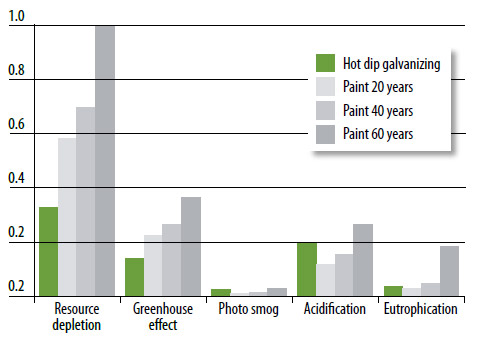Life Cycle Assessments (LCA) to compare corrosion protection systems
When it comes to possible corrosion prevention systems for steel structures, the choice often lies between Hot Dip Galvanizing and paint. In addition to classical criteria for selecting suitable systems such as service life, functionality or costs, ecological considerations are also increasingly important.
A study by the Environmental Technology Systems Department of the Institute for Environmental Protection Technology at the Technical University of Berlin involved a comparison between a paint coating (as EN ISO 12944) and Hot Dip Galvanizing (EN ISO 1461) on the basis of a life cycle assessment.
Comparative life cycle assessment
The ecological life cycle assessment is a recognised method in accordance with EN ISO 14040 ff., which can be used to compare products or product systems in ecological terms. It is based on
the entire life cycle of the product, i.e. manufacture, use, conversion and/or disposal. This involves analysing all environmentally relevant substances which are extracted from the environment (e.g. ores, crude oil) together with substances which enter the environment (e.g. wastes, emissions)
and listing them in a life cycle inventory. The inventory data is converted into several so-called effect categories, which constitute the result of a Life Cycle Amount. The effect category best known
to the public is the greenhouse effect, a measure of the emission of greenhouse gases and the global warming of the atmosphere.
Findings
The study shows that the life cycle assessment is a meaningful method, based on actual practice
of ecological comparison of products. It brings out marked differences between two established corrosion prevention systems for steel structures. The Hot Dip Galvanizing corrosion prevention system displays lower environmental impact for a steel structure with a long service life, as against a paint system. Long service life and freedom from maintenance, the well-known advantages of Hot Dip Galvanizing, are the basis for the environmental benefits of the process.
Summary
Life cycle assessment (LCA) is a practical and scientific tool for ecological product comparison
Hot Dip Galvanizing has big advantages for long life application and other studies show that over
an even shorter lifetime of 40 or 20 years the results do not change significantly.
Hot Dip Galvanizing Process Efficiency and Recycling
In the galvanizing process, iron or steel articles are dipped into a bath containing molten zinc just above its melting point. Any zinc that does not form a coating on the metal remains in the bath
for further re-use. Galvanizing residues, which consist of dross – a mix of zinc and iron, and zinc ash, are recovered and zinc recycled for further use, often in the galvanizing process.
As well as zinc recovered from these residues, recycled zinc from other sources, such as zinc scrap, if often used in galvanizing. Galvanized steel can be recycled easily with other steel scrap
in the steel production process. Zinc volatilises early in the process, is collected as dust and is then recycled.
Improvements in gas burner technology have also undoubtedly improved energy efficiency
in heating the galvanizing bath. Exhaust heat is not wasted and is used to heat pre-treatment chemicals or dry work prior to immersion.
The galvanizing industry is committed to understanding and improving of the life-cycle environmental performance of its process and products. Galvanizers Association has recently helped establish
a Pan-European Life Cycle Inventory database for general galvanizing. This LCI will allow Environmental Product Declarations and other life cycle assessments to be made on structures involving galvanized steel.


